All the trams are modified Corgi 4 wheelers, repainted in Midnight Blue (Humbrol No 15) and White (Humbrol No 22) finished with bespoke transfers. They represent both the English and French cars which made up the fleet in 1910 and all have Tenshodo motors, of 28.7 or 31mm wheelbase, modified for live overhead.
Current collection is by PC Trams dwarf base trolley poles on the enclosed cars and simple trolley poles, made of piano wire, on the open topped trams. Because it is springy piano wire appears to be the best material to use with less de-wiring especially at the reversers.
The open toppers have had the lower rail removed to allow fitting of a glazing strip round the upper deck to represent the "Moseley" windscreens fitted to these trams when supplied.
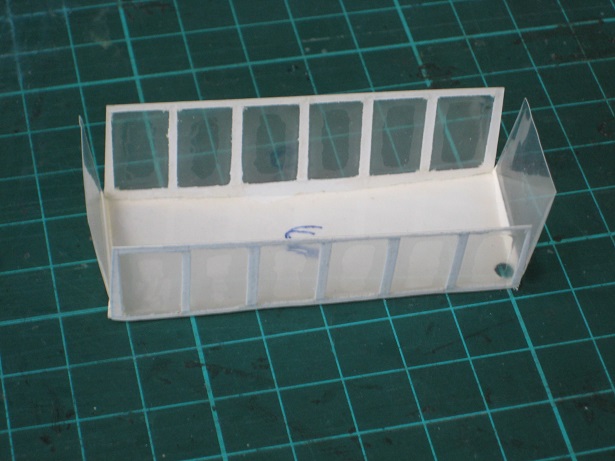
|
Two of the trams have had the number of upper saloon side windows changed and one of these has also had the number of lower saloon windows changed.
This was achieved by cutting away the two central window pillars and all of the quarter lights before drawing the correct window style onto paper four times actual size.
These were reduced to the correct size and copied onto thin card. After cutting out the windows the card was painted white, laminated, cut to size, scored, folded and fitted to the tram replacing the original glazing.
|
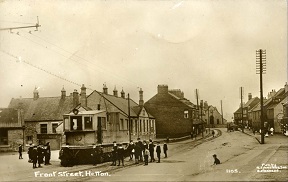
|
The Sunderland District Tramways only works car was a Track Sweeper / Snow Broom supplied in 1906 by Brecknell, Munro and Rogers of Bristol.
The period postcard, supplied by John Carlson, shows the car in Front Street, Hetton-le-Hole.
|
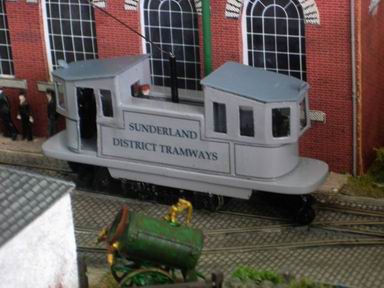
|
In 2012 a model of the Works Car was built. The body is made from card and is mounted on a motorised brass chassis and its construction is described on the Building the Works Car page.
|
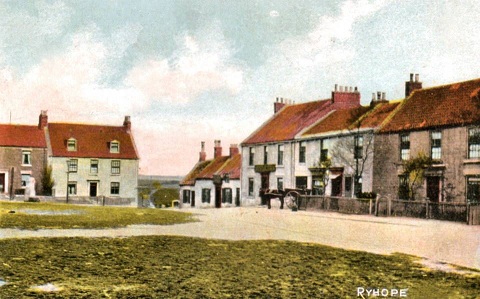
|
This period postcard shows Ryhope before the arrival of the Sunderland District Tramway.
The road between the houses on the left of the gap and the cottages on the right was too narrow and too sharp for the trams.
To allow the road to be widened No.1 The Village, on the left of the road, was altered by the Tramway Company.
|
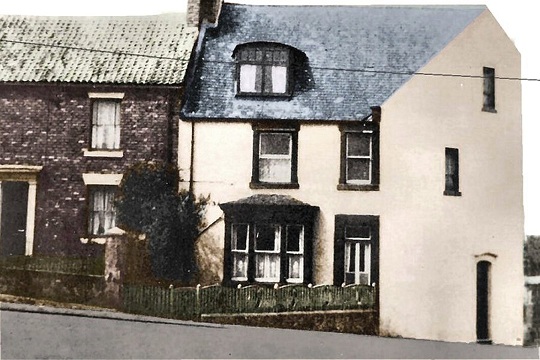
|
This is No.1 The Village after the Tramway Company completed their extensive alterations to it seriously reducing its size.
The remains were eventually demolished in 2016 after the roof collapsed, while some alterations were being done, during the 1990's and it became derelict.
Bell kits were used for the houses, No 2 was built as supplied but No.1 was built in its later altered condition.
|
The Durham Collieries Power Station, housing the control panel and shuttle timer, still exists as an industrial unit, and Robinson Bros. Brewery, housing the transformer, still exists as a block of flats, are scratch built using materials left over from building Sunderland Corporation Tramways. Next to Robinson's Brewery there is a scratch built blacksmiths shop with a forge already red hot to make shoes for the horse outside.
The "Car Sheds" still exist and have a steel frame covered with corrugated sheeting and were used until 2002 as a bus garage by the Go-Ahead Group, successors to Sunderland District Transport Company. The model was scratch built from card then covered with Slaters corrugated iron to match the original. Inside the overhead is of inverted brass U section supported by piano wire with a traction pole at each corner. One of the tramway maintenance staff can usually be found under one of the trams in the depot using their new fangled electric welder.
At the Fencehouses end the shop and houses are Metcalfe kits, there is also a scratch built Methodist Chapel based on the one in Chapel Row in Philadelphia close to the "Car Sheds". The final building is an Alphagraphix "Tramcar Inn" which has found its way from the Southwick terminus of the Corporation system!
As it was a rural tramway Village Farm has been included, which has a working horse gin, to drive the barn machinery, driven by a fibre optic lamp motor mounted under the baseboard. Bell kits were used for the house and adjoining barn, but the barn with the horse gin was scratch built and to give the correct texture, all the farm buildings were finished with a mixture of white acrylic paint and fine sand and then weathered. The fields are grass matting with lichen for the bushes. There are cows and sheep in one and the farmer and his horse are about to plough the first furrow in the other.
To allow for easy repair, all of the buildings were built with wood stiffeners and are held in place by screws. After all these were fitted, we tackled the back scenes, which were made from 4mm ply with bracing on the back. The boards were covered on the front with Peco cloudy sky paper, which in turn had buildings from the town scene and fields from the country scene, cut out and stuck onto card, and then attached to help with the illusion of depth. On the horizon behind the "Car Sheds" we added Penshaw Monument, scanned from a photograph.
The road vehicles that make up the scene are mainly horse drawn, from the Lledo Days Gone Range, and are about 1/64th scale. The horse drawn Pantechnicon and delivery van have also been repainted into local period liveries by Gordon. A Matchbox Yesteryear steamroller, driven by a crank from a second fibre optic lamp motor fixed under the baseboard, is rolling the first tarmac to be laid in the area. There is also a Matchbox Yesteryear Yorkshire Steam Lorry, passing the Brewery, delivering sacks of flour in the area.
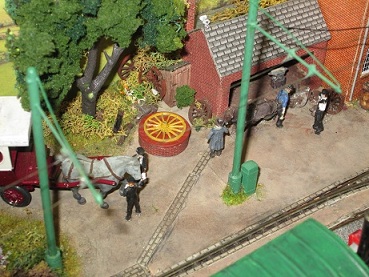 |
In 2013 a number of trees were added and in 2017, as we had a spare white metal wheel, a wheel table complete with a newly made wheel ready to have its red hot iron tyre fitted was added near to the blacksmith and wheelwrights shop.
|
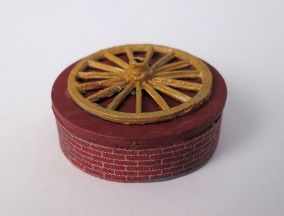 |
The wheel table was made from a 25 mm repair washer, primed and painted rust colour, attached to a piece of dowel covered by a strip of Metcalfe brick paper.
My uncle, H. C. Bulmer, was a blacksmith, joiner and wheelwright and worked from premises just behind our house where there was a wheel table similar to this in his yard.
|
As with Sunderland Corporation a mixture of Dapol 1/72nd and Langley 1/76th people were used on the street and Slaters 1/76th people inside the trams. The other street furniture is from model railway sources. All the people were painted by Margaret using acrylic paints and were then placed in small scenes to complete the tramway.
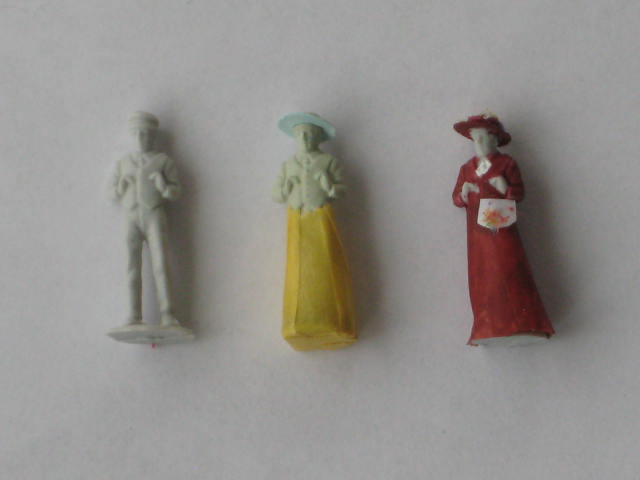
|
As a number of different ladies in Edwardian costume were needed and there were only a limited number of Langley Edwardian ladies, Margaret converted some Dapol men into Edwardian ladies.
The skirts are made with pieces of Tamiya 6 mm masking tape running from the waist to the base and four or more were used for each, depending on the waist size of the figure.
|
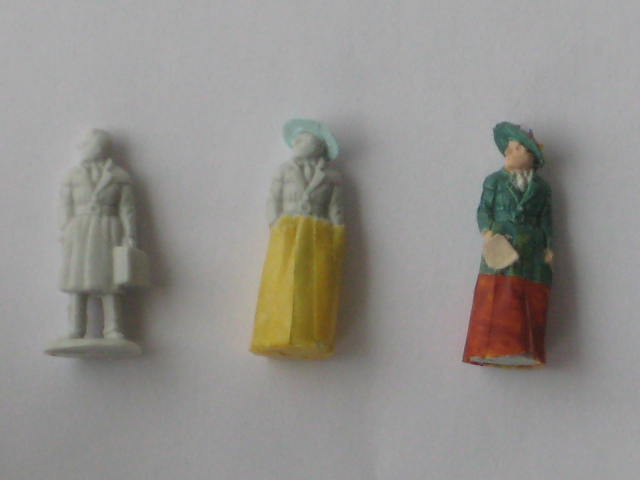
|
The hats were made from card perforated with a hole punch with a small hole in the centre of the punched out circle, glued if a slack fit, on the head of the figure.
All figures were painted as you would get dressed, so skin first, then hair, blouse (or shirt), skirt (or trousers), jacket and finally shoes, bags, umbrellas etc. last.
|
"Sunderland District" was completed in time to be present at Perth Green Model Railway Exhibition in March 2005 where it celebrated the 100 th anniversary of the opening of the District Tramway. It has since been successfully shown at many model railway exhibitions around the North East of England and at the Festivals of Model Tramways in Manchester in 2006 and 2008 and was sold in 2019.
© Gordon Bulmer 2021








